Operation Spark. Assault on the "Ladoga Fortress"
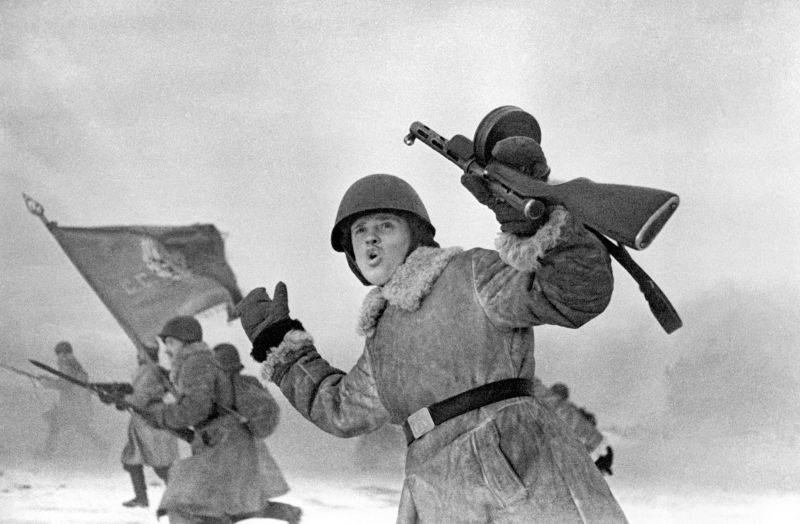
Soviet soldiers on the attack near Leningrad during an operation to break the blockade
General situation
By the beginning of 1943, the situation in Leningrad, surrounded by German troops, remained extremely difficult. The troops of the Leningrad Front (LF) and the Baltic Fleet were isolated from the rest of the Red Army. Attempts to de-blockade Leningrad in 1942 - the Lyuban and Sinyavin offensive operations, did not bring success. The shortest route between the Leningrad and Volkhov fronts (VF) - between the southern coast of Lake Ladoga and the village of Mga (the so-called Shlisselburg-Sinyavino ledge, 12-16 km), was still occupied by units of the 18th German army.
Leningrad was under constant shelling, it was attacked by the enemy aviation. People died, buildings collapsed. The second capital of the USSR by November-December 1942 was heavily depopulated. As a result of mass mortality, evacuation and additional conscription, the population of the city decreased by 2 million in one year and amounted to about 650 thousand people (according to other sources - about 800 thousand citizens). The vast majority of the remaining population was employed in various jobs. The lack of land communication with the territory under the control of the Red Army caused great difficulties in the transport of fuel, food and raw materials for factories.
However, the situation of the townspeople in the winter of 1942-1943. it was still much better than the previous winter. Some of the Leningraders even received an increased food ration compared to the all-Union. Electricity from the Volkhovskaya hydroelectric power station was delivered to the city through a cable laid under water in autumn, and fuel was delivered through an underwater pipeline. The city was supplied with the necessary products and goods through the ice of the lake - the "Road of Life", which resumed work in December. In addition, in addition to the highway, a 35-kilometer iron siding was also built right on the ice of Lake Ladoga. Day and night, multi-meter piles were continuously driven, which were installed every two meters.
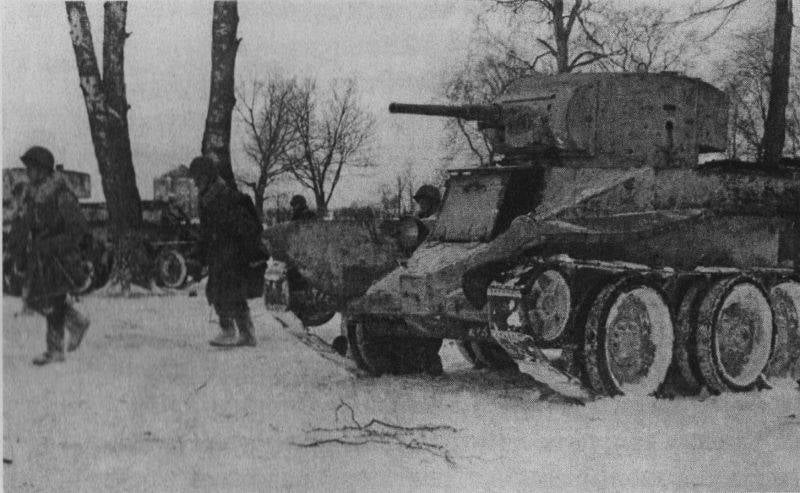
Soviet Tanks BT-5s and infantry pile up before the attack in the area of breaking through the blockade of Leningrad. January 1943
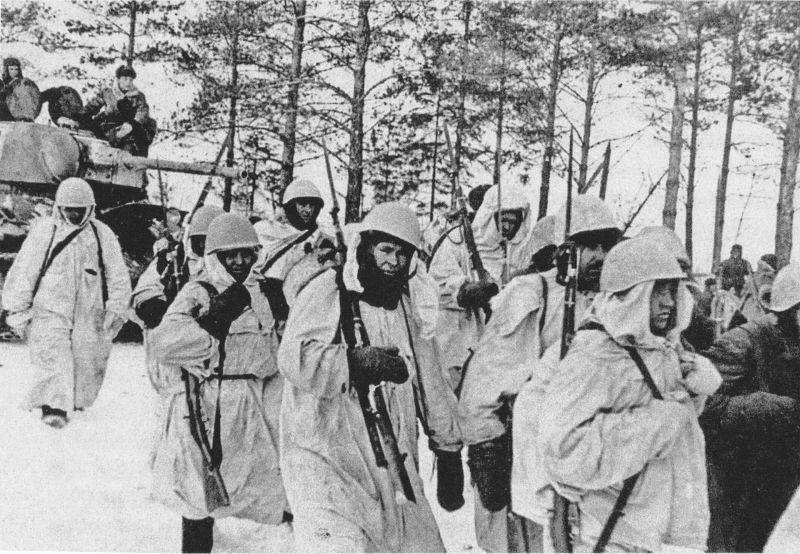
The infantry and tanks of the 152nd Tank Brigade of Colonel P.I. Pinchuk are preparing for the offensive. Leningrad front. Operation Spark.
Side forces. the USSR
THE USSR. The troops of the Leningrad and Volkhov fronts, part of the forces of the Baltic fleet and long-range aviation. By the end of 1942, the Leningrad Front under the command of Leonid Govorov included: the 67th, 55th, 23rd, 42nd armies, the Primorsky task force and the 13th air army. The main forces of the LF - the 42nd, 55th and 67th armies, held the defense at the turn of Uritsk, Pushkin, south of Kolpino, Porogi, the right bank of the Neva to Lake Ladoga.
The 67th Army operated in a 30-kilometer strip along the right bank of the Neva from Poroga to Lake Ladoga, having a small foothold on the left bank of the river in the Moscow Dubrovka area. The 55th Rifle Brigade of this army guarded the road from the south, which passed through the ice of Lake Ladoga. The 23rd Army defended the northern approaches to Leningrad, located on the Karelian Isthmus.
It should be noted that the situation on this sector of the front was stable for a long time, even a soldier’s saying appeared: “Three (or “there are three neutral”) armies are not fighting in the world - Swedish, Turkish and 23rd Soviet.” Therefore, the formations of this army were often transferred to other, more dangerous directions. The 42nd Army defended the Pulkovo line. The Primorsky Operational Group (POG) was located on the Oranienbaum bridgehead.
The LF supported the Red Banner Baltic Fleet under the command of Vice Admiral Vladimir Tributs, which was based at the mouth of the Neva River and in Kronstadt. Leningrad was also supported by the Ladoga military flotilla. The air defense of Leningrad was carried out by the Leningrad Air Defense Army.
The troops of the LF were separated from the troops of the VF by a 15-kilometer corridor - the Shlisselburg-Sinyavino ledge, which closed the ring of the blockade of Leningrad from the land. By the beginning of 1943, the Volkhov Front under the leadership of Kirill Meretsky included: the 2nd shock army, the 4th, 8th, 52nd, 54th, 59th armies and the 14th air army. But the direct participation in the operation was taken by: the 2nd shock army of General Romanovsky, the 54th army of Sukhomlin, the 8th army of Starikov and the 14th air army of Zhuravlev. They were located in a 300 km strip from Lake Ladoga to Lake Ilmen. On the right flank from Lake Ladoga to the Kirov railway, units of the 2nd shock and 8th armies operated.
For the offensive, strike groups of the Leningrad and Volkhov fronts were formed, which were significantly reinforced by artillery, tank and engineering formations, including those from the reserve of the Headquarters of the Supreme High Command.
In total, the strike groups of the two fronts numbered over 300 thousand soldiers and officers, about 4 guns and mortars (caliber 900 mm and above), more than 76 tanks and almost 600 aircraft.
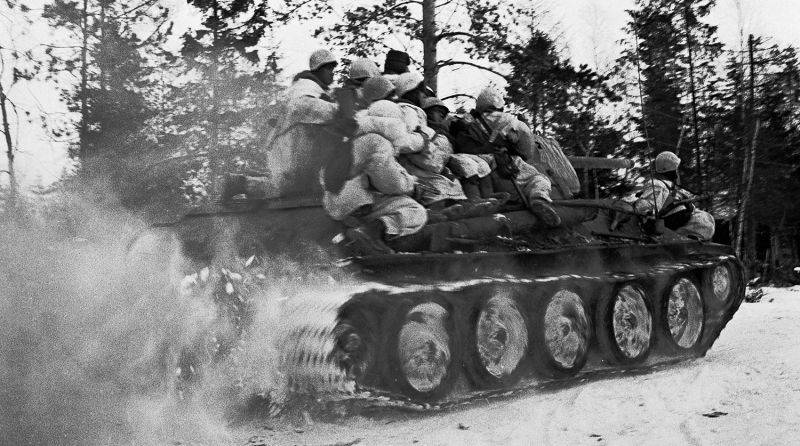
Troopers on the armor of the T-34 tank are heading to the front line in the Sinyavino area
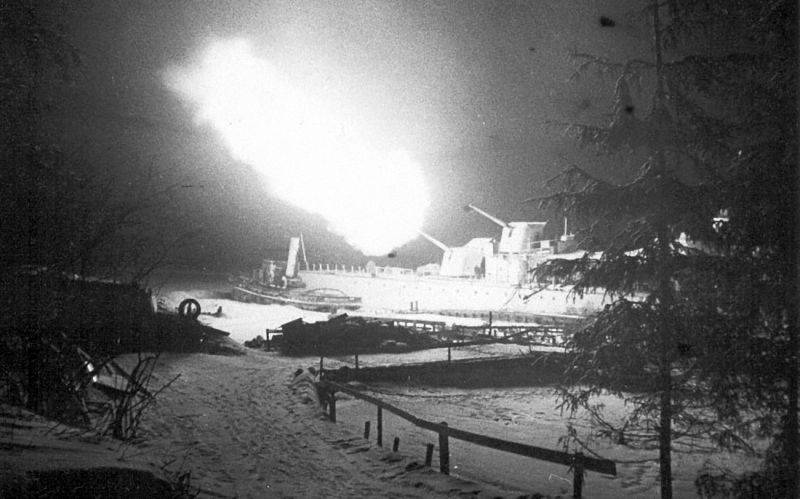
The destroyer of the Baltic Fleet "Experienced" is shelling enemy positions in the area of the Nevsky Forest Park. January 1943
Germany: "Ladoga Fortress"
The German high command, after the failure of attempts to take Leningrad, was forced to stop the fruitless offensive and order the troops to go on the defensive. All the attention of the German headquarters was riveted to the bleeding, turned into ruins, but not surrendering Stalingrad. In the fall of 1942, the transfer of troops to the Stalingrad direction began from Army Group North.
The 8th air corps was transferred to the Stalingrad region. Manstein, who was supposed to take Leningrad before that, left with his headquarters. The 18th Panzer, 12th Motorized and several infantry divisions were taken from the 20th German Army. In return, the 18th Army received the 69th Infantry, 1st, 9th and 10th Airfield Divisions. The airfield divisions were numerically inferior to the infantry in terms of armament and quality of combat training.
Thus, the German group near Leningrad decreased not only quantitatively, but also deteriorated in terms of quality.
The Soviet fronts were opposed by the 18th German Army under the command of Georg Lindemann (Lindemann), which was part of Army Group North. The army had 4 army corps, up to 26 divisions in total. The German troops were supported by the 1st Air Fleet of Aviation Colonel General Alfred Keller. In addition, on the northwestern approaches to the city, opposite the 23rd Soviet Army, there were 4 Finnish divisions from the Karelian Isthmus Task Force.
The Germans had the most powerful defense and dense grouping of troops in the most dangerous direction - the Shlisselburg-Sinyavino ledge. Here, between the city of Mga and Lake Ladoga, 5 German divisions were stationed - the main forces of the 26th and part of the divisions of the 54th Army Corps. They included about 60 thousand people, 700 guns and mortars, about 50 tanks and self-propelled guns. There were 4 divisions in the operational reserve.
Each village was turned into a stronghold prepared for all-round defense, the positions were covered with minefields, wire fences and fortified with pillboxes. From the side of Leningrad, the defense was held by the regiment of the 227th Infantry Division of General von Scotty, the 170th Infantry Division of General Zander in full force and the regiment of the 5th Mountain Division, which had up to 30 tanks, about 400 mortars and guns.
The defensive line of the Germans passed along the left bank of the Neva, the height of which reaches 12 meters. The coast was artificially iced, heavily mined, and had almost no convenient natural exits. The Germans had two powerful knots of resistance. The first one is the constructions of the 8th HPP, brick houses of the 1st and 2nd towns; the second - numerous stone buildings of Shlisselburg and its outskirts. For every kilometer of the front, there were 10-12 bunkers and up to 30 guns and mortars, and full profile trenches stretched along the entire bank of the Neva.
The middle defensive line passed through the workers' settlements No. 1 and No. 5, the Podgornaya and Sinyavino stations, the workers' settlement No. 6, and the Mikhailovsky settlement. There were two lines of trenches, a Sinyavinsky knot of resistance, cut-off positions, and strong points. The enemy used wrecked Soviet tanks, turning them into fixed firing points. They bordered the Sinyavin Heights - the approaches, the sole and the western slopes, as well as the Kruglyaya grove.
From the Sinyavin Heights, the southern coast of Lake Ladoga, Shlisselburg, the 8th hydroelectric power station and the working settlement No. 5 were clearly visible. This line was the position of the divisional reserves (up to one regiment) of the German group. The entire space was under flank fire from neighboring strongholds and centers of resistance. As a result, the entire ledge represented one fortified area.
The 227th Infantry Division (without one regiment), the 1st Infantry Division, the regiment of the 207th Security Division and the regiment of the 223rd Infantry were defending against two armies of the Volkhov Front. The defensive line of the enemy passed from the village of Lipka through the workers' settlement No. 8, the Kruglaya grove, Gaitolovo, Mishino, Voronovo and further south. There was a continuous trench along the front line of defense, covered with minefields, gouges and barbed wire, and a second trench was also dug in some areas. Where the swampy terrain did not allow to go deep into the ground, the Germans erected ice and bulk ramparts, put up two-row log fences. Lipka, the working settlement No. 8, the Kruglaya grove, the villages of Gaitolovo and Tortolovo were turned into especially powerful centers of resistance.
The situation for the attacking side was aggravated by the wooded and swampy terrain in the area. In addition, there was a large area of Sinyavino peat extraction, which was cut by deep ditches and additionally reinforced with wood-earthen, peat and ice ramparts. The territory was impassable for armored vehicles and heavy artillery, which were needed to destroy enemy fortifications. To overcome such a defense, powerful means of suppression and destruction were required, as well as a huge effort of the forces and means of the attacking side.
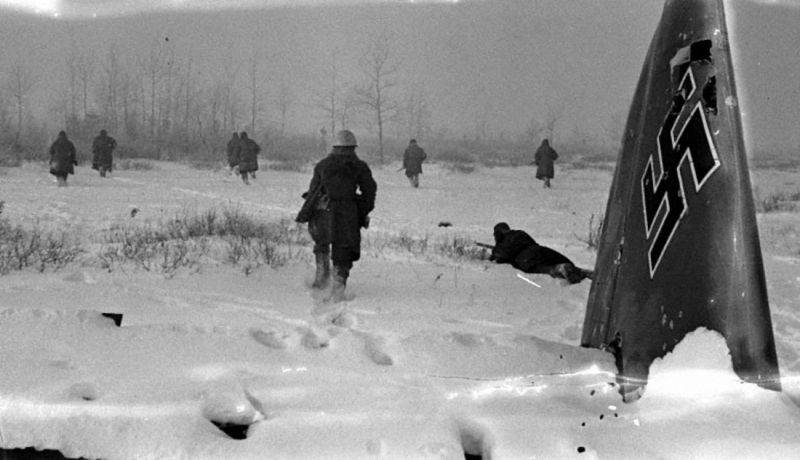
Red Army soldiers of the Leningrad Front advance on a copse near the wreckage of a downed German aircraft
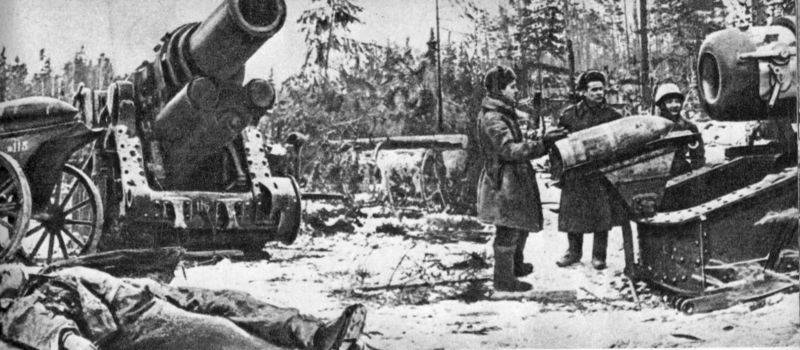
Soviet officers inspect heavy German guns shelling Leningrad. These are two 305-mm M16 mortars of Czech production by Skoda. January 1943
Plan
In November 1942, General Govorov sent a report to the Headquarters of the All-Russian Supreme Command, in which it was proposed to carry out two operations east and west of Leningrad - Shlisselburg and Uritskaya in order to lift the blockade of Leningrad, to ensure the construction of a railway along the Ladoga Canal and thereby organize a normal communication between Leningrad and the country. The headquarters suggested focusing on one direction - Shlisselburg.
The LF command improved the plan of operation. It provided for counter strikes - Leningrad from the west, Volkhov - from the east in the general direction of Sinyavino. On December 2, 1942, the Headquarters approved this plan. The coordination of the actions of the two fronts was to be carried out by K. Voroshilov and G. Zhukov. The start of the operation was scheduled for the beginning of 1943.
Specific tasks for the troops of the LF and VF were defined in Directive No. 170703 of the Headquarters of the Supreme Command of December 8, 1942. It demanded by joint efforts of the two fronts to defeat the enemy grouping in the area of Lipka, Gaitolovo, Moscow Dubrovka, Shlisselburg and thus
To carry out the operation, two shock groups were formed: in the VF - the 2nd shock army of General Romanovsky, in Leningrad - the 67th army of Dukhanov. The strike force of the LF was to cross the Neva on the ice, break through the defenses in the Moscow Dubrovka, Shlisselburg sector, defeat the enemy who had dug in here, connect with the troops of the VF and restore Leningrad's connection with the mainland. In the future, it was planned that the formations of the 67th Army would reach the line of the river. Washing.

Prepare
The attack group of the VF was supposed to break through the defenses in the Lipka, Gaitolovo sector (width 12 km) and, inflicting the main blow on Sinyavino, seize the Rabochesky Settlement No. Ensuring the left flank of the 1nd shock army was entrusted to the 2th army of General Starikov, which, with its right-flank formations, was to advance in the direction of Tortolovo, pos. Mikhailovsky.
Air support and cover for the troops was provided by the 13th and 14th air armies of the two fronts and the aviation of the Baltic Fleet (about 900 aircraft in total). Long-range aviation, coastal and naval artillery of the fleet (88 guns) were also involved in the operation.
The basis of the strike force of the LF was the 67th Army, built before the offensive in two echelons. The first echelon consisted of the 45th Guards, 268th, 136th, 86th Rifle Divisions, the 61st Tank Brigade, the 86th and 118th Separate Tank Battalions. The second echelon consisted of the 13th, 123rd rifle divisions, 102nd, 123rd, 142nd rifle brigades, and the army reserve - 152nd and 220th tank brigades, 46th rifle division, 11th , 55th, 138th rifle, 34th and 35th ski brigades. The offensive was supported by the artillery of the army, the front and the Baltic Fleet - a total of about 1 guns and mortars and the 900th Air Army with 13 aircraft.
The strike force of the VF included the 2nd shock army, part of the forces of the 8th army. The first echelon of the 2nd shock army consisted of the 128th, 372nd, 256th, 327th, 314th, 376th rifle divisions, the 122nd tank brigade, the 32nd guards tank breakthrough regiment, 4 separate tank battalions. The second echelon included the 18th, 191st, 71st, 11th, 239th rifle divisions, the 16th, 98th and 185th tank brigades. The army reserve consisted of the 147th Rifle Division, the 22nd Rifle Division, the 11th, 12th and 13th Ski Brigades.
Part of the forces of the 8th Army operated on the left flank of the offensive: the 80th, 364th rifle divisions, the 73rd marine brigade, the 25th separate tank regiment and two separate tank battalions. The offensive was supported by the artillery of the front and the two armies with more than 2 guns and mortars and the 800th Air Army with about 14 aircraft.
Thus, the 67th and 2nd shock armies were significantly strengthened due to reserves and the transfer of formations from other directions. Soviet troops outnumbered the enemy in this area in infantry by 4,5 times, in artillery - by 6-7, in tanks - by 10 and in aircraft - by 2 times. In the 67th Army, over 13 guns and mortars of 1-mm caliber and more were concentrated on the 900-kilometer section of the breakthrough, which made it possible to increase the artillery density to 76 guns and mortars per 146 km of the front.
On the Volkhov Front, in the direction of the main attack in the breakthrough sector of the 327th Rifle Division (width 1,5 km), the density of guns and mortars per 1 km of the front was 365 units, in the breakthrough sector of the 376th Rifle Division (width 2 km) - 183, and in the auxiliary direction - 101 guns and mortars per 1 km of the front. All tank units (on the LF - 222 tanks and 37 armored vehicles, on the VF - 217 tanks) were planned to be used for direct support of the infantry.
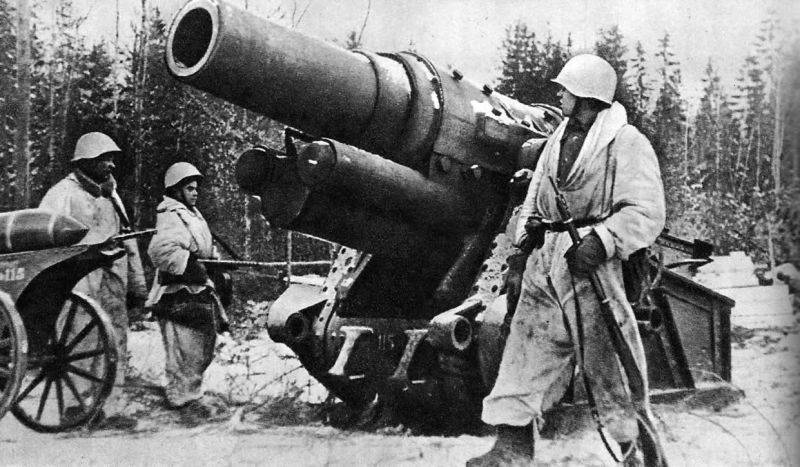
Heavy 305 mm mortar M16 of Czech production, captured by Soviet soldiers. District of Leningrad
They prepared for the offensive throughout December 1942. At the end of December, the command of the fronts asked the Headquarters to postpone the start of the offensive to a later date, due to extremely unfavorable weather conditions, which led to a prolonged thaw and, as a result, insufficient ice thickness on the Neva and poor passability of the marshes.
The units and formations of the 67th and 2nd shock armies were replenished and rearmed. The troops accumulated from 2 to 5 rounds of ammunition, depending on the systems of guns and mortars. The most time-consuming and hard work was the preparation of the initial areas for the shock groupings of the fronts. It was necessary to increase the number of trenches and communication passages, shelters for personnel, open and equip firing positions for artillery, mortars, tanks, and arrange ammunition depots.
The total volume of earthworks on each front was in the hundreds of thousands of cubic meters. All work was carried out only by hand, at night, without violating the normal behavior of the troops occupying the defense, in compliance with camouflage measures. At the same time, sappers were building roads and columned paths, gati through the swamps, which abounded in the starting areas, cleared minefields, and prepared passages in the barriers.
The troops of the 67th Army were preparing means to overcome the high bank of the Neva and sections of the damaged ice cover. For this purpose, hundreds of board shields, assault ladders, hooks, ropes with hooks and "cats" were made. After considering a number of options (including creating a canal in the ice of the Neva, followed by building a pontoon bridge, or reinforcing the ice by freezing cables into it), it was decided to transport tanks and heavy artillery across the Neva along wooden "rails" laid on sleepers.
On sections of the Neva in the city limits, they worked out ways to overcome damaged areas of ice, storming a steep, icy, fortified shore with bunkers. In the units allocated for the breakthrough, assault detachments and obstacle groups were created to make passes and destroy the most durable defensive structures.
83 assault detachments were formed at the VF, including sappers, machine gunners, machine gunners, flamethrowers, artillery crews and escort tanks. Particular attention was paid to the development of methods for storming tree-earth barriers, peat, snow and ice ramparts.
Great importance was attached to operational camouflage. The enemy only managed to establish shortly before the start of the operation that the Soviet troops were preparing for an offensive. The commander of the 26th Army Corps, General Leiser, taking this into account, suggested that the commander of the 18th Army, General Lindemann, withdraw troops from Shlisselburg. But this proposal was not accepted.
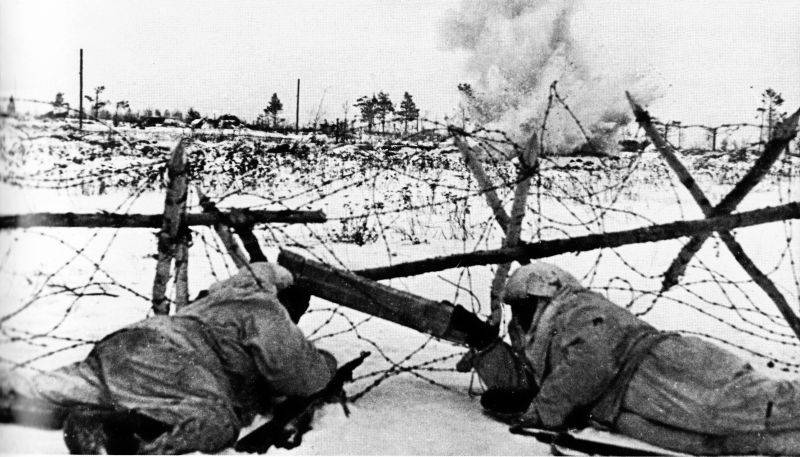
Sappers of the Volkhov Front during the battle at the wire barriers
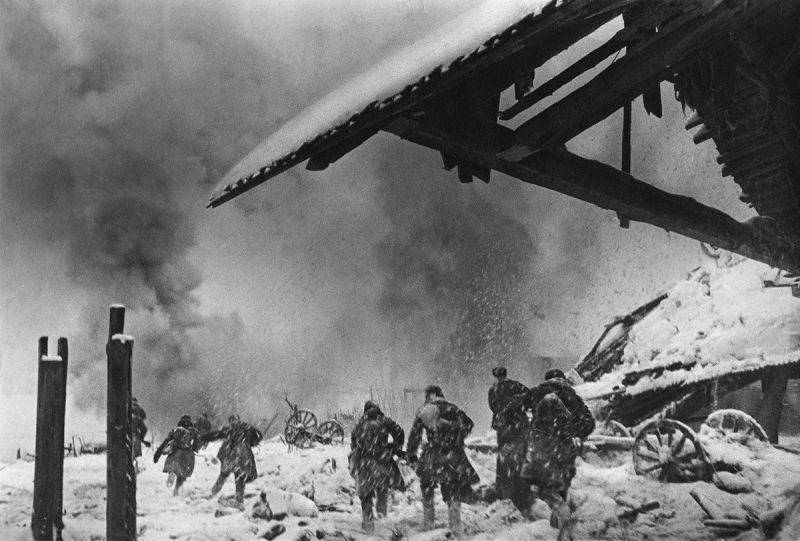
Troops of the Volkhov Front in the battle for the village
Beginning of the offensive
On the morning of January 12, 1943, the troops of the two fronts simultaneously launched an offensive. At night, Soviet aviation dealt a powerful blow to the positions of the German army in the breakthrough zone, as well as to airfields, command posts, communications and railway junctions in the enemy rear.
At 9:30, artillery preparation began: in the offensive zone of the 2nd shock army, it lasted 1 hour 45 minutes, and in the sector of the 67th army - 2 hours 20 minutes. 40 minutes before the start of the movement of infantry and armored vehicles, ground attack aircraft attacked previously reconnoitered artillery, mortar positions, strongholds and communication centers.
At 11:50 a.m., under the cover of a "barrage of fire" and the fire of the 16th fortified area, the divisions of the first echelon of the 67th Army went on the attack. Each of the four divisions - the 45th Guards, 268th, 136th, 86th Rifle Divisions, were reinforced by several artillery and mortar regiments, an anti-tank artillery regiment and one or two engineering battalions. In addition, the offensive was supported by 147 light tanks and armored cars, the weight of which could withstand the ice.
The particular complexity of the operation was that the defensive positions of the Wehrmacht went along the steep, icy left bank of the river, which was higher than the right. The German fire weapons were located in tiers and covered all the approaches to the coast with multi-layered fire. In order to break through to the other side, it was necessary to reliably suppress the firing points of the Nazis, especially in the first line. At the same time, care had to be taken not to damage the ice near the left bank.
The assault units were the first to cross the Neva, followed by riflemen and tanks along the passes. In a stubborn battle, our troops broke into the enemy defenses north of the 2nd Gorodok (268th rifle division and 86th separate tank battalion) and in the Maryino area (136th division and 61st tank brigade). By the end of the day, Soviet troops broke the resistance of the 170th German Infantry Division between the 2nd Gorodok and Shlisselburg. The 67th Army occupied the bridgehead between the 2nd Gorodok and Shlisselburg, construction of a crossing for medium and heavy tanks and heavy artillery began (completed on January 14).
On the flanks, the assault was not so successful. On the right wing, the guardsmen of the 45th division in the area of \u86b\uXNUMXbthe "Neva Piglet" were able to capture only the first line of enemy fortifications. On the left wing, the XNUMXth Infantry Division was unable to cross the Neva at Shlisselburg. Therefore, the division was transferred to the bridgehead in the Maryino area in order to strike Shlisselburg from the south.
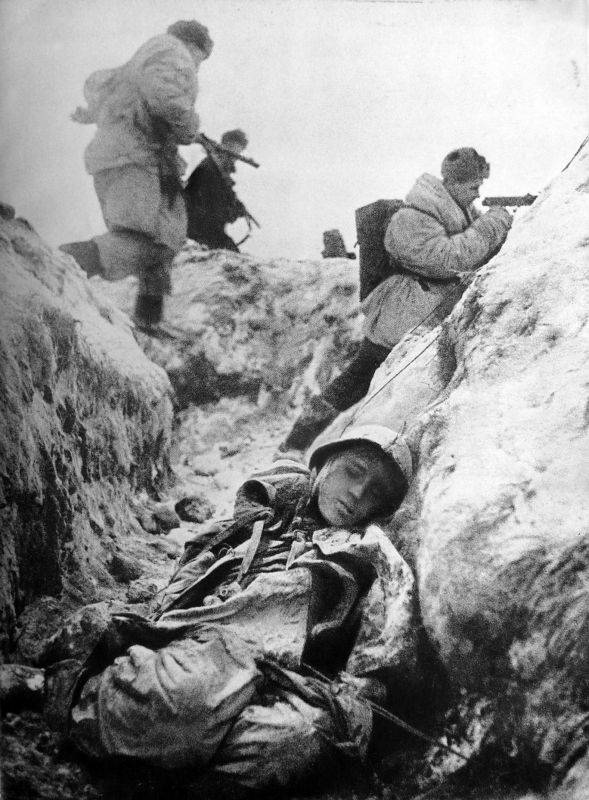
Soviet soldiers in the attack near Leningrad during the beginning of the blockade breaking
In the offensive zone of the 2nd shock and 8th armies, the offensive developed heavily. Aviation and artillery were unable to suppress the main enemy firing points, and the swamps were difficult to pass even in winter. The most fierce battles were fought for the points of Lipka, Workers' Settlement No. 8 and Gontovaya Lipka. These strongholds were on the flanks of the breaking through forces and continued the battle even in complete encirclement.
On the right flank and in the center - the 128th, 372nd and 256th rifle divisions, were able to break through the defenses of the 227th infantry division by the end of the day and advance 2-3 km. The strongholds of Lipka and Workers' Settlement No. 8 could not be taken that day. On the left flank of the offensive, only the 327th Rifle Division was able to achieve some success, which occupied most of the fortification in the Kruglyaya grove. The attacks of the 376th division and the forces of the 8th army were not successful.
On the first day of the battle, the German command was forced to commit operational reserves into battle: formations of the 96th Infantry Division and the 5th Mountain Division sent the 170th Division to help, two regiments of the 61st Infantry Division (Major General Huner's group) were introduced into the center of the Shlisselburg-Sinyavino ledge.
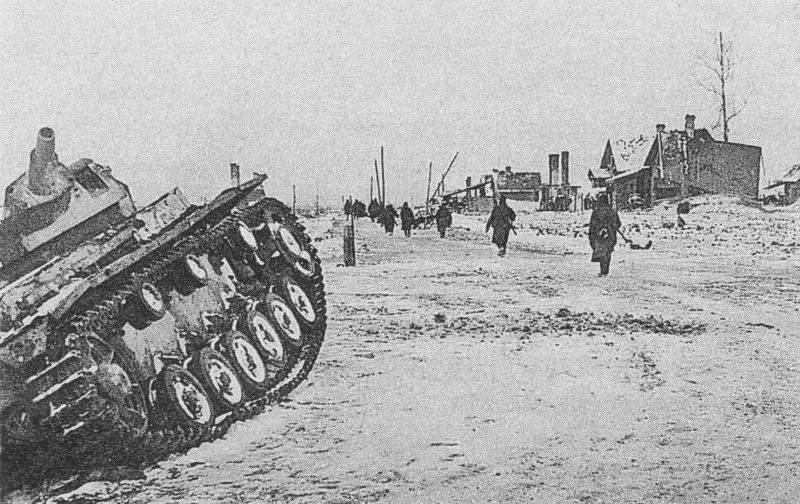
Abandoned tank Pz. Kpfw. III in a settlement in the area of breaking the blockade of Leningrad
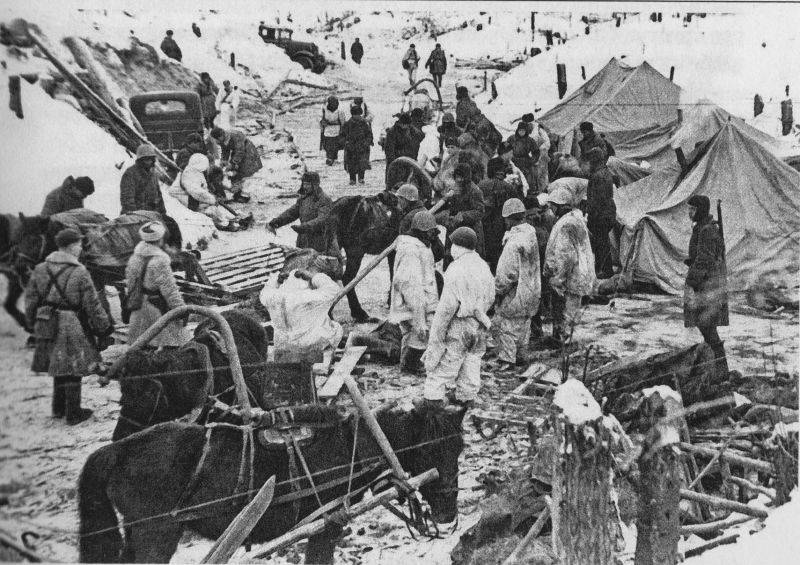
The near rear of the Soviet units in the area of breaking the blockade of Leningrad
To be continued ...
Information